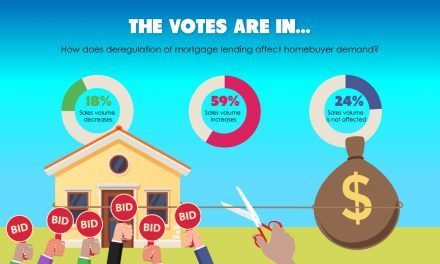The National Association of Home Builders (NAHB) is sounding the alarm about declining housing affordability.
The NAHB’s Housing Opportunity Index has declined over the past year, now at its lowest reading since 2018. As of the second quarter (Q2) of 2020, just 59.6% of new and existing home sales were accessible to households earning the U.S. adjusted median income of $72,900. This is down from 61.3% in Q1 2020.
With occasional ups and downs, the index has declined steadily from when the NAHB first began reporting the index in 2012. At that time, a whopping 78.8% of homes were accessible to median income households.
What has changed to make the index fall?
Three major criteria:
In 2020, interest rates have fallen to historic lows, which is a positive for what is commonly termed affordability. In other words, homebuyers are able to put more of their monthly payment toward paying principal rather than interest, therefore they can qualify for larger home purchase prices with the same monthly mortgage payment as before when interest rates were higher.
But today’s lower interest rates have not been enough to counter the other two factors: home prices have continued to rise at a pace exceeding incomes.
Editor’s note — first tuesday usually avoids metrics that use median figures, since these are abstractions, not applicable to any singular household or home transaction. While the Housing Opportunity Index relies on median figures, it presents useful trends. Still, look to local sales and incomes for the most accurate picture of your market.
Home prices will fall to meet incomes
The number of homebuyers in a market stems directly from employment income, which, along with interest rates, determines buyer purchasing power.
Home price increases are unsustainable when they exceed an area’s average rate of income growth. Here in California, this has been the case since 2013, when prices rose over 25% in that single year alone.
Home price increases have since fallen back somewhat, now 4% higher than a year earlier in the high tier and 6% higher in the low tier as of July 2020. This rise still exceeds income increases.
In fact, while local income changes are not yet available for 2020, the Bureau of Labor Statistics (BLS) reports national real weekly earnings increased 3.3% from a year earlier as of August 2020. But, the BLS cautions, this does not mean everyone’s incomes have increased over that period of time. Rather, this pace of increase reflects the job loss experienced mainly by lower-income individuals. In other words, there are fewer low-income earners being tracked to drag down wage earnings, which results in a deceptive boost to average incomes.
For real estate professionals, what you need to know is this: home prices continue to outpace most incomes. Therefore, home prices will undoubtedly fall in the months ahead.
Job losses have already pulled back home sales volume this year, and jobless homeowners have caused 90+ day mortgage delinquencies to rise significantly, which will lead to a wave of foreclosures down the road. Both of these factors will also contribute to the downward pull on prices.
Expect home prices to fall heading into 2021, bottoming around 2022-2023, at which point a jobs recovery will begin to take shape. Real estate professionals who will survive the next two years of down sales and lower prices will need to get creative and plan ahead.
Related article:


















